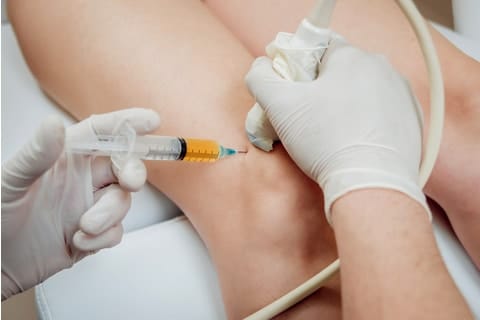Viscosupplementation injections involve the injection of a thick fluid called hyaluronic acid into the joints to improve lubrication and reduce pain associated with conditions like osteoarthritis. Hyaluronic acid is a naturally occurring substance found in the synovial fluid that cushions and lubricates the joints. However, in osteoarthritis, the natural production of hyaluronic acid diminishes, leading to joint pain and stiffness. Viscosupplementation injections aim to replenish this lost hyaluronic acid, restoring joint lubrication and cushioning, which can alleviate pain and improve mobility.
These injections are often recommended for individuals with mild to moderate osteoarthritis who have not experienced sufficient relief from other conservative treatments like oral medications or physical therapy.
Viscosupplementation injections are typically administered in a clinical setting by a healthcare professional. Before the injection, the area around the joint may be cleansed, and a local anesthetic may be applied to minimize discomfort. The hyaluronic acid is then injected directly into the affected joint using a thin needle. Depending on the joint being treated, the injection process may involve guidance from imaging techniques such as ultrasound to ensure accurate placement of the needle.
After the injection, patients are usually advised to avoid strenuous activities for a short period and to apply ice to the injected area to reduce any temporary discomfort or swelling. The frequency and number of injections required may vary depending on the individual’s response to treatment and the severity of their osteoarthritis.
Viscosupplementation injections are most commonly performed on weight-bearing joints that are frequently affected by osteoarthritis, such as the knee. However, they can also be used to treat osteoarthritis in other joints, including the hip and shoulder. In some cases, viscosupplementation injections may be considered for joints in the hands or feet affected by osteoarthritis, although this is less common.
The decision to perform viscosupplementation injections on a particular joint depends on various factors, including the severity of osteoarthritis, the individual’s overall health, and their treatment goals. Healthcare providers will assess each patient’s condition and recommend the most appropriate treatment approach based on their specific needs.

Viscosupplementation usually lasts longer than cortisone shots (six months rather than several weeks or months like steroid injections).
After treatment, it’s important to follow aftercare instructions to maximize the treatment’s effectiveness and minimize complications. Here are some general guidelines:
Rest: Limit weight-bearing activities for the first 48 hours following the injection. Avoid strenuous activities such as jogging, heavy lifting, or high-impact sports for a few days to allow the joint to heal.
Ice Application: Apply ice to the injection site to reduce swelling and relieve pain. Ice the area for 15-20 minutes several times a day for the first few days.
Pain Management: You may experience mild pain or discomfort at the injection site. Over-the-counter pain relievers like acetaminophen can be used to manage this. Avoid using anti-inflammatory drugs such as ibuprofen or aspirin immediately after the procedure, as they can interfere with the healing process.
Monitor for Complications: Watch for signs of infection such as increased redness, swelling, or a fever. If you experience these symptoms, contact your healthcare provider immediately.
Follow-Up Care: Attend follow-up appointments with your healthcare provider to monitor the progress of your treatment and discuss any concerns.
Gradual Return to Activity: Gradually increase your activity level as recommended by your healthcare provider. It may be beneficial to engage in physical therapy to strengthen the muscles around the joint and enhance mobility.
By adhering to these aftercare instructions, you can help ensure a smooth recovery and improve the outcomes of your viscosupplementation treatment.